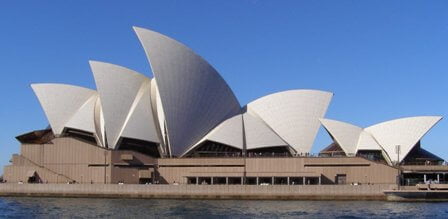Famous Sydney Opera House is the multi venue of performing arts center in the Sydney, in the country of Australia. The building was located on the foreshore of the Sydney Harbor. It was one of the most famous buildings in the world. It was also considered a distinctive building. This building was a work of art in the realm of 20th century architectural design.
Famous Sydney Opera House designer is Danish architect “Jorn Utzon”. However, it was completed by an Australian architectural team. The team was headed by Peter Hall. The building had formally opened by the “Queen Elizabeth II” on 30th October 1973.
In the year 1957, the gestation of the project was begun with Jorn Utzon’s selection as the winner of an international design competition. The government of New South Wales, Australia was led by Premier “Joseph Cahill” the building construction work to begin in 1958.
Planning for the Sydney Opera House design began in the late 1940s. The director of the “New South Wales State Conservatorium of Music Eugene Goossens” is lobbied for the suitable venue for large theatrical productions.
The Fort Macquarie Tram Depot was occupied the site at the time of the plans. It was demolished in 1958. Construction began on March of 1959.

Jorn Utzon was directed the construction of Sydney Opera House. He was worked on the project alongside the government. In this time, the government’s decision was overshadowed due to the circumstances. These circumstances included cost and scheduling overruns. Finally, the architect “Jorn Utzon” was resigned due to this circumstances.
The Sydney Opera House and its surroundings are occupied the whole Bennelong Point located at Sydney Harbor. Bennelong Point is situated at Sydney Cove and Farm Cove. The Sydney Harbor Bridge is nearby the location of adjacent to the “Sydney central business district & the Royal Botanic Gardens”.
The Sydney Opera House was consists of several performance venues.
Sydney Opera House collectively hosts more than 1,500 shows each year and is attended by more than 1.2 million people. Many artists are performed their performances in the Sydney Opera House.
In this Sydney Opera House mainly involved 3 companies’ performances. Those company names are “Opera Australia, the Sydney Theatre Company, and the Sydney Symphony Orchestra”.
Famous Sydney Opera House was one of the most popular visitor attractions in Australia.
The Sydney Opera House was visiting by more than 8 million people annually.
Approximately 350,000 visitors are took tourist guides in the building each year.
The Sydney Opera House was managed by the “Sydney Opera House Trust”. It was an agency of the New South Wales State Government.
In 28th June 2007, The Sydney Opera House had become the UNESCO World Heritage Site. It has listed on the register of the National Estate since the year 1980.The National Trust of Australia registered the building in 1983. In the year 2000, The City of Sydney Heritage Inventory also registered the building.
Historical monument Sydney Opera House was also the finalist in the New 7 Wonders of the World.
Sydney Opera House design features modern expressionist and the series of large precast concrete shells. It has also a recording studio, cafes, retail shops, restaurants and bars.
Visitors can take frequent tours of the house spaces. Daily backstage tours are also available. Backstage tours allow visitors to see areas normally reserved for performers and crew members.
Sydney Opera House was built in the 4 stages.
- Stage 1 had begun in (1957-1959) has the planning out the building.
- Stage 2 (1959-1963) constructed of the building upper podium.
- Stage 3 of construction began in 1963 and ended in 1967. It was involved the construction of the outer shells.
- Stage 4 of construction began in 1967 and ended in 1973. Stage 4 involved the interior design and construction of the building. The construction was completed after Stage 4.
Sydney Opera House received the RAIA Merit Award in 1974. It also received the Meritorious Lighting Award of the Illuminating Engineering Society of Australia in 1974. The building received the RAIA Civic Design Award in 1980. It also received the RAIA Commemorative Award.
